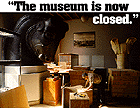 Continued
Continued The University of Chicago Magazine June 1996
The University of Chicago Magazine June 1996 Continued
Continued
conducted as a distinct branch of the University's nearly completed $650-million Campaign for the Next Century--has raised $6.9 million toward its $10-million goal. Groundbreaking should begin this summer for the new south wing, which will house the mechanical systems necessary to provide climate control, as well as desperately needed space for research and storage.
In a gracious, easygoing manner, Sumner chalks out a succinct history of this current project. It begins, as do all things related to the Oriental Institute, with James Henry Breasted. It was Breasted who, with the help of John D. Rockefeller, Jr., founded the Institute in 1919 as a laboratory for the study of the rise and development of ancient civilization.
As University-led excavations in every country of the Near East yielded a burgeoning collection of artifacts, the institute eventually outgrew its original Haskell Hall location. Again with Rockefeller's help, the institute's current facility-with its museum, libraries, labs, and faculty offices-was opened in 1931.
"In those days," says Sumner, "the laws of the various countries we were working in would usually allow us to have half of everything we found. So we built this immense collection." He estimates that "well over 60 percent of the collection has been excavated by our own expeditions. So we have the entire record of where these things came from, what their archeological context and associations were-and that immeasurably increases their value for research.
"This is not somebody's attic," Sumner stresses. "This is an active collection used for research, and it's increasingly used for new kinds of research on the basis of new scientific possibilities, new analytical and instrumental devices." If the artifacts become damaged beyond recognition, such research will have to rely upon records limited by the knowledge and tools available to those who compiled them years before.
The field of museum conservation was "relatively new" in 1969, says Sumner, when the institute commissioned a study by British conservator Nan Shaw that showed, "without any question, that the collection was at risk, and that as the years went by we would suffer increasing loses."
In response, says Sumner, "we hired our first professional
Continue reading, "The Museum is now closed."
Go to:
Return to June 1996 Table of Contents